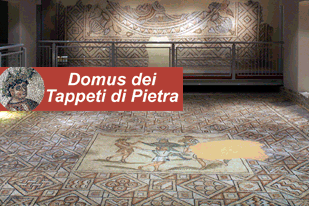Byzantine floors and two Mosaics full of deep mysteries














Byzantine floors and two Mosaics full of deep mysteries. Hotel near Stone Carpets Domus.
Foto: 1)S.Apollinare, mosaic basilica of Classe, Ravenna, 2)Church S.Eufemia, via Barbiani Ravenna, 3)inside the Chuch, 4)baptismal font with inscription, 5)painting of Andrea Barbiani, 6) floor mosaics of the Domus, 7)dance of the Genios of the Seasons, 8)Good Shepard mosaic , 9)Good Shepard mosaic in Mausoleo Galla Placidia,10)detail of the Musico, 11)detail of the Genios of the Seasons, 12)detail of the Genios of the Seasons, 11)emperor Giustiniano, Basilica S.Vitale
One hundred years before Ravenna became the Capital of the Western Roman Empire (after Milan in 402) an episode foreshadowing the future and the epochal supremacy of the city occurred: the story of San Apollinare, first Bishop of Ravenna and Northern Italy, and the possible identification of the Church of Santa Eufemia as the first Christian cult site in Ravenna (the access to the Domus is through the little church of Santa Eufemia, in via Barbiani).
Once inside the church of Saint Eufemia, which is characterized by a great simplicity, we can follow some clues starting from a suggestive framed painting above a baptismal font, clearly visible in the small hall behind the altar quoting " Here the faith of Ravenna began".
The writing is lighted by a canvas by Andrea Barbiani (visible in the multi media hall) depicting the baptism given to a magistrate of the imperial fleet and his family by Apollinare. ( all dressed in VIII century clothes !). Also this picture is above the baptismal font, protected by an iron wicket.
The presence of the Saint Bishop in this town is reinforced by another aspect: the relics of Santa Eufemia and Santa Agata in two marble cases, visible from inside the major altar, that, according to the VI century "official biography" were brought here by Apollinare.
The story of the first Bishop ends virtually with the so called "Good Shepard" mosaic which is exhibited lower down in the museum site, realized with furniture from a hall of the imperial period and a semi-immersion bath confirming the practise of the ritual of baptism in the house of the magistrate (than became a church), who was miracolated by Apollinare.
Exploring the underground excavations, we immediately understand why the museum is located on teodoriciana-bizantine floors (VI century).
First because that mosaic flooring can open to us in its entirety; secondly because the different decorative patterns, imageries and colours are considered a readable "unicum" of the fascinating bizantine period.
These mosaics belong to the only private palace of this period, detached from the church by a well-preserved public street cutting in half the archaeological site, and permitting a visible link to be traced with the most famous bizantine mosaics in Ravenna (see the fragment of the original floor in San Vitale), thus completing the whole panorama.
Other two mosaic panels in the exposition show interesting aspects: the more recent one depicts the "Dance of the Genious of the Seasons" and it is contemporaneous with the VI century building; the other one, relating, as we said, to Apollinare Bishop, could be dated back even to Constantine The Great period (IV century) and in this case we could be facing at the first Christian reinterpretation of a mosaic originally created with a different pagan meaning ( the myth of Orpheus) .
This mosaic, in fact, lacks of the identifying symbols of the Good Shepherd of the later Christian tradition: hale and lamb carried on the shoulder of Jesus; nevertheless it is difficult escaping from the rarefied, almost mystic, atmosphere of the composition.
Two big birds, probably peacocks, realized with glass paste and not with the usual marble pieces of the mosaic floors, draw a sort of halo around the young man's head, dressed in a ankle-length tunic, high shoes and a small triangular cloak.
Ha has his instrument - the shepherd and fauns' lute - hung on a three, maybe a cypress, and he leans upon his thin stick while his hand makes as if to caress a young fawn's muzzle. Another fawn grazes quietly not so far from them.
From a stylistic point of view, the essentiality of the entire composition, its frontality , flattening and simplification of every naturalistic element, together with a marked expressionism of some particulars (e.g. the shepherd's eyes), show analogies to other contemporaneous pictures from Rimini and Aquileia but they had no place into the artistic contest of Ravenna at the end of IV century.
If we about the extraordinary Good Shepherd in Galla Placidia mausoleum, in fact, dated some decades later, the dominant stylistic distance of Ravenna, capital of Western Roman Empire, results immeasurable.
A different kind of problem is offered by the other mosaic depicting the "Dance of the Genious of the Seasons", even if the different characteristic qualities attributed to the seasons leave no doubts about the right interpretation of the mosaic; what is particular here is the fact that the Seasons are represented as male figures ( even the musician in the back representing Time), whereas elsewhere they are normally depicted as female figures.
Another enigmatic element comes from their circling around: Seasons do not follow one after another as usual, but they are disposed probably according to a symbolic order: Winter sets against Autumn instead of Summer.
Also the ring-a-ring-o'roses is a peculiar element: traditionally, in fact, Seasons are depicted apart or dancing in flight, hand in hand, always following a rectilinear path, like the concept of time is linear in the Christian tradition that escapes from the pagan idea of a never ending circular motion of time.
Therefore, this kind of representation, quiet anomalous, could be the precious "identity card" of its owner as it was exposed in good view at the centre of the dining room, maybe a north-African reproduction picture on an easel, perfectly according to his belief or cultural tastes. A die hard thorn in the side of the political and religious unification pursued by Emperor Giustiniano and basic cause of the war started in Ravenna and fought in Italy during 535 and 553.
Prof.Gianni Morelli
The pleasure of fine accommodation in the centre of Ravenna: we recommend the Fabbri hotels for a pleasant stay as follows:
The Centrale Byron Hotel, 3-star hotel in the centre of Ravenna, close to the main momuments;
The Bisanzio Hotel, 4-star hotel in the centre of Ravenna, close to the main momuments;
Once you have reached the hotel and parked your car, forget it and walk everywhere, because everything is within walking distance.
The railway station is near our hotels and within walking distance





